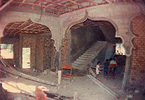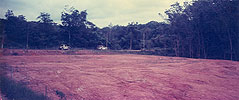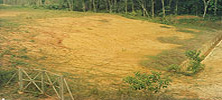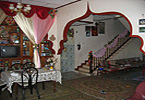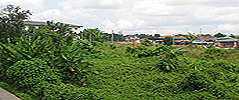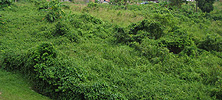| Previous Unloads: | |
|
1991 May: A Visit to Langkawi, the Land of Mahsuri 1991 Aug: Study tour to Medan, Indonesia 1994 May: First Asia Pacific Chitin and Chitosan Symposium (APCCS) 1997 Dec: Rally Nationwide Vision 1998 Apr MOU and Launching of Chito-Chem (M) Sdn Bhd 1999 Sep: The Officiation of Smart Technology Centre, UKM 1999 Dec: Study Tour to Taiwan 2000 Jul: A MiniReunion of Class of 66 2000 Dec: Just An Unlucky Day |
2001 Jul: 29th Covocation of UKM 2001 Dec: Digging Deep Into the Root: SKBT Revisited 2002 Sep: A Consequential Events from Feb 2002 2003 Apr: Reminiscing the Little Boy 2003 Nov: Reunion of Class of 66 2004 May: Cameron Highland Revisited 2004 Jul: In the Heart of Two Cities 2005 Jan: SAS Re-revisited 2005 Apr: In the Backyard (and Frontyard) |
In the backyard (and Frontyard, Sideyards, and Insideyard) (Dated: Apr 2005)
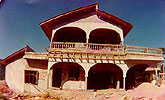 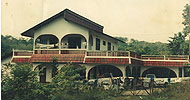 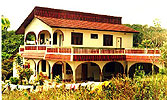 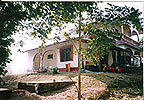
We live here, in the "suburb" of Bangi. It is actually a kampung. When we moved in in 1987 our home was surrounded by secondary "forest" formed after the rubber plants were deserted by their owners - they sold the land actually; the new owners first razed the ground out of eagerness, then left it to the nature which "reclaimed" by "painting" it with secondary bush. There were only five houses when we move in; the nearest next house was a kilometer away, deep into the local dwellers homes. It was a place full of serenity, it was very quite from eleven at night and was always cold especially at night. Taptibau woke us in the morning, and alerted us of sun-set; | |||||||||
|
|||||||||
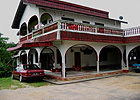 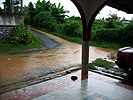 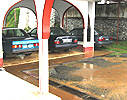 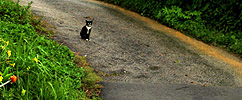
The manace of manly-attribution, or plausibly a non-matter of civic, the art of living together, even a cat wonders; | |||||||||
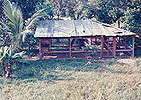  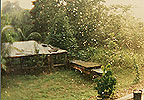 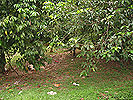 
My backyard orchard had been contributing with not less than many thanks. The chicken barn was built soon when we moved in 1987; at one time we had about fifty chicken of all ages, and almost provided suficient eggs for our family. However their enemies were too at large; in one night, six chicken were swallowed by a giant python, it took two Firemen to haul it out of the barn at six in the evening of the same day; unrarely we saw in the afternoon, baby chicken were being swallowed by the monitor lizards with the legs still kicking. So we stopped rearing chicken, and the barn was demolished in 1993. The chicken actually originated in Bangi in 1983 Jul, when my #3son Zidni was born. An acquaintance of ours, MakChik Tuminah of the late En Ahmad Keromo, my working-camp adopted family in Sg Merab in 1972, visited him and Azizah, she brought a long a life hen; she said to be slaughtered to extract the essence, she said for a quicker recovery (Zidni stayed two weeks in incubator in Pantai Medical Centre, Kuala Lumpur after birth for respiratory inexpansion sindrome). I did not have the gut to slaughter it, instead we petted it; I made a small barn for it. After six months we thought of pairing it, so we bought a rooster from Pak Etek, our land-neighbour of Sungai Buah (where Zidni's umbilical cord, as well as Rubaini's, was buried - Malini's in England; Muzani's in Bangi's 31, 1/3C; the rest here in Sg Merab; as well as Arifah's, my first grandsibling -daughter). They live very well and born some eggs for us. When we moved to Sg Merab in late 1987, the chicken moved with us. We let them have their own natural family as we were, and they really had a very happy super-extended family; | |||||||||
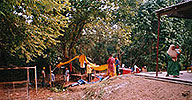  
The jambu air (pink fruit) was planted in 1988 from a baby plant we bought in pasar malam; it grew up like a broiler; it never stop bearing fruits that we could never consume them all that we let it lived with its own natural deeds and needs; nonetheless it kept giving us a growing shadow at any time of the day. | |||||||||
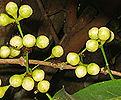 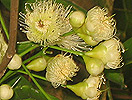 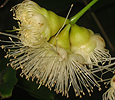 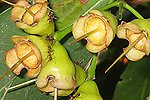 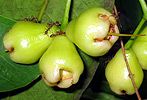 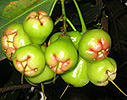 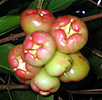  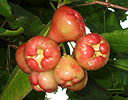
From flower to the fruit, to ensure, life would continue, to serve; | |||||||||
 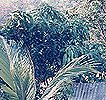   
Three coconuts trees had since been cut down because they were too high already that they might pose a hazard when high wind turn up. But we were more concerned about its straight rise that it would be a task to bring down at later time when it is too high. All four mango trees were cut down because the one we planted were the urban type, not the rural type, so they never bear fruits. A ciku grew up to bear fruits, but was cut down because it blocked the chicken barn. A guava was also cut down, even though it born fruits. A durian tree was also cut down for similar reason; it never gave fruits although it flowered non-stop. Perhaps it was a male one. | |||||||||
   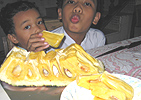    
The jack fruit, the tree of which we planted in 1988 from the seeds whose fruit we took from the mother tree grown on Kamal's TOL home in Kampung Tengah, Lembah Jaya, Ampang. It was among the earliest that born fruits, as early as 1993. Most of the times we share the fruits with a school of hanuman langur, and squirrel; especially the bananas, rambutans, cempedak (a sister of jack fruit); we were wondering why the jambu air, the one we let to live by itself, is not the hanuman favourite; | |||||||||
   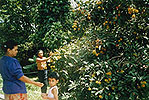  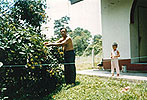 
Every rambutan had been contributing several times a year. It was a convenient desert in the afternoon after lunch; fresh from the trees. The first to bear the fruits was the one at the back. Once a high wind turned up, the rambutan almost uprooted. It took six young men (fortunately during the visit of AbangWi et al) to upright it again. Now it is a grown up to full nature that when it bear fruits, hanuman langurs first noticed it before us, and they have better advantage than us in picking; there is one rambutan tree that is suffering from bark stripping from the menace of the hanumans. All trees are of local origin; but one special rambutan of type known as "chembong" (big, round fruit, sweet, and thick flesh); I brought it in the middle of 1990 from Terengganu; it was vegetated from a daughter tree in the home of AbangWi which was in turn was vegetated from the mother tree grown in my origin-home, perhaps planted by my father or my mother which I remembered all my life while in Terengganu. It grew well here and had born fruits a few times, but not yet to full volume; | |||||||||
  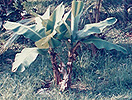 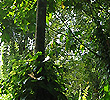 
Wild banana, for their leaves only, for use in the kitchen, such as for grilling or stewing fish, and for imparting banana leave scent to cooked rice. Domesticated banana, naturally for the fruits. Although it horticulture is very simple, we never put a serious effort in it. But one banana I brought from Terengganu; its fruits were purple when growing, and red when ripe. It born fruits twice in two generations, then they were neglected because the fruits were very slimy, even the hanumans were not quite keen (some said this banana was used in religious ceremony by the hindus). A cashew tree from a baby I took at the vicinity of Telaga Batin Airport, Terengganu, was planted in 1989 at the south-east corner of the boundary. It assimilated well into the nature of the surrounding. When it was young we used to pluck its shoot during meal time; the star fruit we bought at pasar malam was similarly planted at the south-west corner, and it was similarly assimilating itself with the nature and had gone wild. We missed many of its fruits because of unnoticed; | |||||||||
      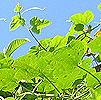 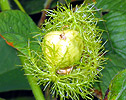  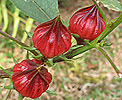 
The quick pick for the kitchen: kesom, pandan, kadok, kari; cekor manis which had become "enau" among the bunga kertas; kacang kelisa (kacang botor) lived well on the wild guava; the "ulat bulu" (wild melon - all are brought here from some where) with the fruit well wrapped, for bubur lambuk, or mixed black-pepper boiled veg; together with the red fern (pucuk midin), grown wild around the yard. We attempted many times with the serai, but always got consumed off before it could grow; and lemon trees which always ceased to grow from infestation of red caterpillar; the rosselle fruits from the wildly grown trees for quick cordial drinks; a plant unrealising it grow not in a desert; | |||||||||
 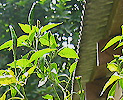 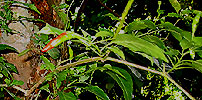 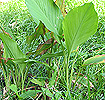 
Ubi kayu (cassava) is more for its shoot than its tuber, it turned wild now; cili api grew wild to the roof-high, or trying to foster the dokong; the kunyit is more for it leaves than its tuber, just like the wild banana; lengkuas was planted by Pak Zid in 1986 for the tuber (Thais recipes are full of chili api and lengkuas). Somehow we never attempt the ginger. Except the formost, all the rest needed supplements from pasar malam for our kitchen; | |||||||||
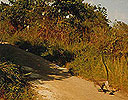 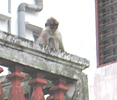   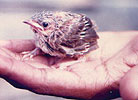 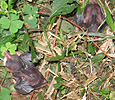 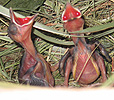 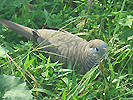  
To this date we are battling the hanuman langur, always in schools, and squirrels who demand their share; especially for the bananas, rambutans, cempedak (a sister of jack fruit). We were wondering why the jambu air, the one we let to live by itself, is not the hanuman favourite; a bird nest fall to the ground, manaced by the hanuman langur, the chick we nursed until it could fly; two orphans we found on the ground whose home might have been brought down by bigger animals, lost from the mother, we tried very hard to bring them up (for possible mynah bird which could be tamed to pets) but we failed severely; a "balam" biologying in the grassy bush; an elusive monitor lizard; somebody's home under the green leaves; | |||||||||
 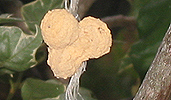 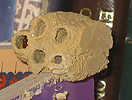 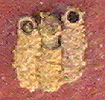 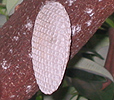
Some more homes; | |||||||||
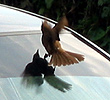 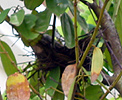 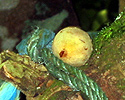 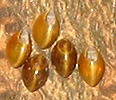 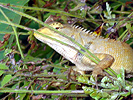
Frolicking from the nest above; dale's fruit store; a kind of tree snails; iguana; | |||||||||
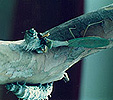 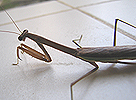 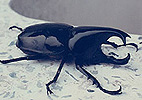  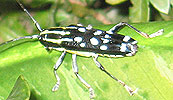 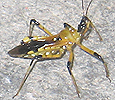 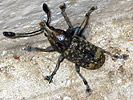 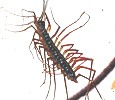 
The ubiquitous insects; a praying manthis preying on a green caterpillar; a rare fighting horn-beetle made a visit; the bees on the roof-top; spotted beettle; a rare beetle; very leggy one; centiped on business tour; | |||||||||
 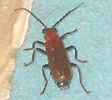 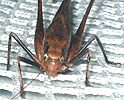    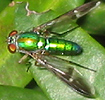 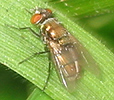  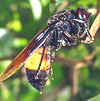 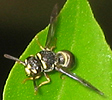 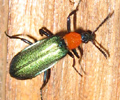
Six-leggers, therefore an insects; and flies; a hornet; and a small one; a red-green beetle; | |||||||||
 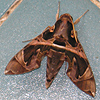 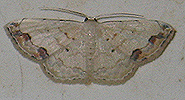 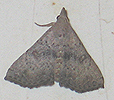 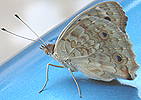 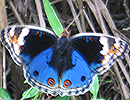  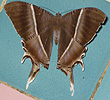   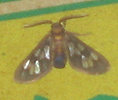 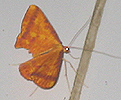  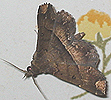 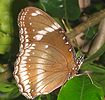 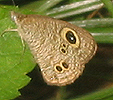 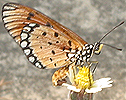
The various kinds moths and butterflies; | |||||||||
 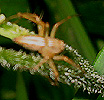 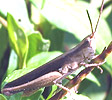 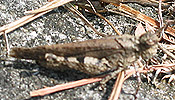 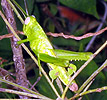 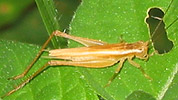 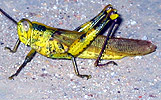
A green-grasshopper; a brown-grasshopper; grasshopper; grasshopper; grasshopper; grasshopper; | |||||||||
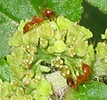  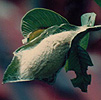 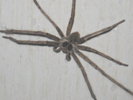  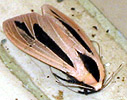
The ubiquitous kerengga on flowers and fruits; a kind of "micro"snail or caterpillar which feed only on kari leaves; a moth shed its eggs on guava leaves, its pupa was as big as a silk moth (bombii moryx), only that it was not silky white, chokolate instead; a butterfly swung the front "lobby"; a brown house spider; a yellow garden spider; a badger; | |||||||||
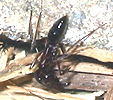 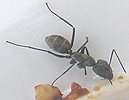 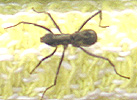 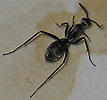  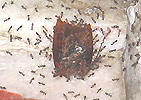 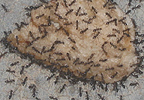  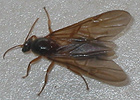 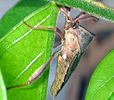 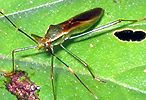 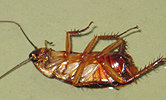
A very nasty ant, the giant ant; the headless ant (miraculously still busy moving around); another giant ant; another giant ants; a school of small ants working on for a 'tribal' feast; and one of thousands of the unfortunate mosquitoes; flying-ant; kesing; and the green type; the ubiquitous cockroach; | |||||||||
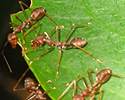 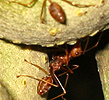 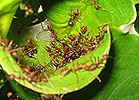 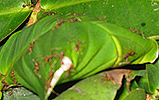 
Kerengga on the job; | |||||||||
  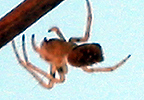 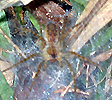 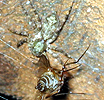  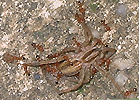  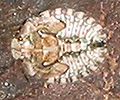 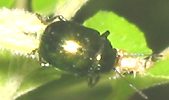 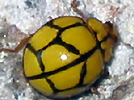
The spiders and some ladybirds; | |||||||||
 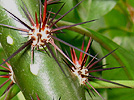 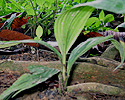     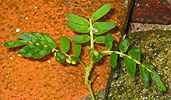 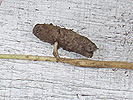  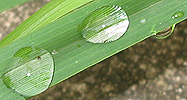
The herbal plants: the "jantung-hati", said to be for diabetes and hypertension; the "seven-thorn", said to be for breast and cervix canser; "kelapa lemba", its fruits and flowers, they said will lower the hypertension, some others said it is a potential sugar substitute of natural origin; "selusuh kucing" they said for mother-to-be; "misai kucing" they said for stone prevention; lempoyang for migraine; "dukung anak" for general purpose health; a date seed of unknown date somehow germinated with a very long first shoot and root; a fractal leaves; some water for fauna; | |||||||||
    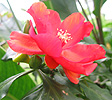 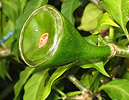 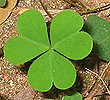
A vegetative plant flowering; the bud, the flower, and the fruit of duri tujuh; three ways love makes a perfect hexagon; | |||||||||
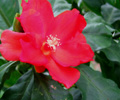 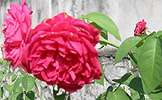  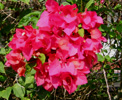  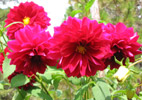 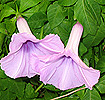 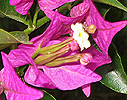  
Some plants for the flowers and some that smell nice: the "duri-tujuh" produces bright-red flower, akin to rose, despite its thorny stem; the rose; yellow trumpet; bunga kertas; a flower from Cameron Highland; extremely flower; the morning glory; the actual flower of 'bunga kertas'; the hibiscus, extremely red, full of stemens, but no fruit; | |||||||||
 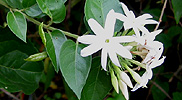 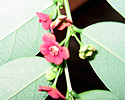 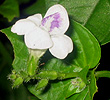 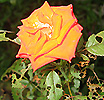
a pink flower; sweet-smelling melor; cekor manis hides its flower below the leaves; a small hedge-row white flower; an orange rose; | |||||||||
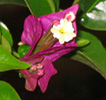 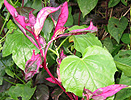 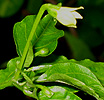    
A white "flower" in a pink flower; pink leaves of flower-colour; white innocent flower which will produce red-hot fruits; | |||||||||
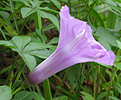 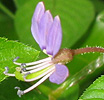    
A morning glory and two other contending violets; against three whites of respective variety; | |||||||||
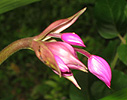    
A palm orchid; kadok flower, but it reproduce by its root; the green fern; striped keladi; a pair of fruits well antler-decorated; | |||||||||
 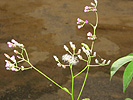 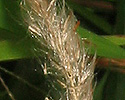 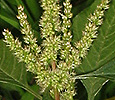  
To tell a grass or any carpeting plant one from the others is best by its flower; | |||||||||
     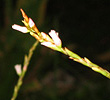 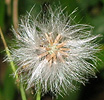
| |||||||||
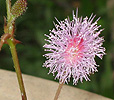 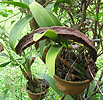   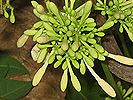 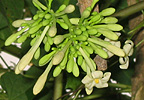
Mimosa; the shy orchid flowers infrequently, well acquainted wildly with kacang kelisa; the papaya that always got menaced by hanuman every time it has fully leaved; and this male betik always born beutiful white flowers, but never the fruit; | |||||||||
   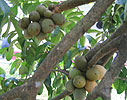    
In 2004 Nov, the dokong, horticultured in the same year the house was constructed (1985), began to give us their sweet langsat-duku combination. This is the remaining few of the trees that we planted that give us the fruits. It was grown from the seeds, the fruits of which was brought here by the house builder Pak Zid from his home town in Pattani, Thailand. From the two kilos fruits that Pak Zid brought to us, several seeds were germinated in two discarded paint-cans; when they were sufficienly strong and enough number of leaves, they were transfered per se to the plot at two different locations; they grew up at a different rates; the slower one was inhibited further by the frequent manace of the hanuman langur to the resultant size-wise of one to ten. Judging by its lack of branches, it would take many more years to bear fruits; | |||||||||
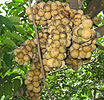    
We are waiting for the langsat (two trees) we planted from the seeds the fruit of which were given to us by Pak Etek of Sungai Buah at about the same year; and we are also waiting for the duku, the baby of which was the one that survived from the forty odd babies we brought from Terengganu in early 1990's; (another one survived in Sg Buah); | |||||||||
